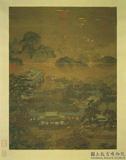明徐渭寫生 卷
推薦分享
資源連結
連結到原始資料 (您即將開啟新視窗離開本站)後設資料
- 資料識別:
- 故畫001638N000000000
- 資料類型:
- 類型:繪畫
- 型式:靜態圖像
- 著作者:
- 徐渭
- 主題與關鍵字:
- 牡丹 蓮荷 菊 蘭.蕙 竹 繡球 茶花 玉簪花 石榴 水仙 梅(白.紅.蠟梅)
- 出版者:
- 數位化執行單位:國立故宮博物院
- 格式:
- 本幅 29.1x525.6公分、隔水一 8公分、隔水二 8公分
- 關聯:
- 石渠寶笈初編(養心殿),上冊,頁622&*故宮書畫錄(卷八),第四冊,頁45&*故宮書畫圖錄,第十九冊,頁301-306&* 徐渭(西元一五二一-一五九三年),浙江山陰人。字文清,更字文長,號天池,晚號青藤老人。山水、人物、花、蟲、竹、石,無不超逸。自評所作,謂書第一,詩二,文三,畫四,識者許之。 此段繪梅幹一株,向下垂展,圈花點蕊,皆蒼勁爽朗。數筆濃潤的竹葉夾雜,益顯恣肆沈酣,天趣淋漓。&*Hsu Wei (style name Wen-ch’ing and Wen-ch’ang; sobriquets T’ien-Ch’ih and Ch’ing-t’eng lao-jen) was a native of Shan-yin. All of his depictions of landscapes, figures, flowers, insects, bamboo, and stones were exceedingly untrammeled. According to his own ranking, he considered his calligraphy best, poetry second, writing third, and painting fourth. Those who know his works would agree. This is a painting of the trunk of a plum tree descending as it spreads out. The circular blossoms and dotted stamens are all rendered powerfully and vigorously. The bamboo leaves mixed in were done with several dark and rich brushstrokes. They abundantly reveal Hsu Wei’s extremely quick and naturally uninhibited style.&*徐渭(1521-1593),明代文學家、書畫家。初字文清,改字文長,號天池,晚號青藤老人。浙江山陰(紹興)人。自幼機智聰敏,九歲能文,年二十為生員,屢次應考鄉試不中。中年為浙閩軍務總督胡宗憲幕僚,後來胡宗憲因案入獄,徐渭懼怕受到牽連,一度驚嚇發狂。晚年病發歸里,窮困潦倒。其善詩文,工書法,中年始學繪畫,出筆瀟灑,自然天成,特長花鳥,與陳淳(1484-1544)並稱。自評所作,認為書第一,詩二,文三,畫四,此評甚得後人讚許。 畫墨花十一種,旁各有七言詩題一首。這類採一圖搭配一文形式的花卉長卷,是畫家所常用的繪畫表現方式,也就是利用詩文加強說明,反映出畫家筆下水墨寫意的形貌。通幅用筆或圈花點蕊,或鈎花撇葉,皆出筆勁健爽朗;或一筆而下或大筆點垛而成的葉片,亦是酣輰淋漓,和畫家存世的大寫意花卉卷相較,此作筆墨雖不到潑辣放縱,亦為瀟灑率意之力作。(張華芝)&*1.劉芳如,〈明徐渭寫生〉,收入國立故宮博物院編輯委員會編,《畫梅名品特展》(臺北:國立故宮博物院,1991年元月初版),頁91。 2.〈明 徐渭 寫生〉,收入譚怡令、劉芳如、林莉娜主編,《滿庭芳 歷代花卉名品特展》(臺北:國立故宮博物院,2010年十二月初版一刷),頁170。 &*徐渭(1521-1593),字文長,號天池,晚號青藤老人。藝術才具極高,曾自評書第一、詩二,文三,畫四。所畫花卉,筆勢縱放淋漓,與陳淳並稱「青藤白陽」,對晚明以後的畫壇影響深遠。 本卷共寫墨花十一種,各段並自題七言詩一首。通幅用筆或圈花點蕊,或鈎花撇葉,出筆率皆勁健爽朗。或一筆而下或大筆點垛而成的葉片,亦是酣輰淋漓。若與徐渭存世的大寫意花卉卷相較,此作雖未臻潑辣縱放的程度,亦屬其瀟灑率意之力作。 (20110102)&* Xu Wei (style name Wenchang; sobriquet Tianchi; late sobriquet Qingteng laoren) was exceptionally talented in the arts. According to his own ranking, he considered his calligraphy best, poetry second, writing third, and painting fourth. In his flower paintings, his brush force was unbridled and wet, coming to be known together with Chen Chun as “Qingteng and Baiyang” and having a major influence in painting circles after the late Ming. This handscroll contains sketch paintings of eleven types of flowers in monochrome ink, with each section accompanied by a seven-character poem inscribed by the artist. The brushwork throughout the work uses the technique of “circled petals” with dotted centers or outlined flowers with scattered leaves, the direct brushwork being powerful and dashing. Both blades rendered as single brushstrokes and large dots for the blossoms are fluid and moist. Compared with other expressive “sketching ideas” works surviving from the hand of Xu Wei, this painting does not have the same degree of boldness and unrestraint. Nonetheless, it is still a powerful work of ease and directness.(20110102)
- 管理權:
- 國立故宮博物院
授權聯絡窗口
- 國立故宮博物院圖像授權、出版授權、影音資料授權-申請流程說明
http://www.npm.gov.tw/zh-TW/Article.aspx?sNo=03003061






